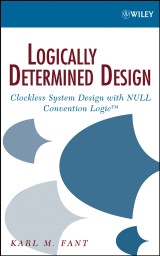Details

Logically Determined Design
Clockless System Design with NULL Convention Logic1. Aufl.
|
141,99 € |
|
| Verlag: | Wiley |
| Format: | |
| Veröffentl.: | 22.02.2005 |
| ISBN/EAN: | 9780471702870 |
| Sprache: | englisch |
| Anzahl Seiten: | 310 |
DRM-geschütztes eBook, Sie benötigen z.B. Adobe Digital Editions und eine Adobe ID zum Lesen.
Beschreibungen
This seminal book presents a new logically determined design methodology for designing clockless circuit systems. The book presents the foundations, architectures and methodologies to implement such systems. Based on logical relationships, it concentrates on digital circuit system complexity and productivity to allow for more reliable, faster and cheaper products.<br /> * Transcends shortcomings of Boolean logic.<br /> * Presents theoritical foundations, architecture and analysis of clockless (asynchronous) circuit design.<br /> * Contains examples and exercises making it ideal for those studying the area.
<p>Preface.</p> <p>Acknowledgments.</p> <p>1. Trusting Logic.</p> <p>1.1 Mathematicianless Enlivenment of Logic Expression.</p> <p>1.2 Emulating the Mathematician.</p> <p>1.3 Supplementing the Expressivity of Boolean Logic.</p> <p>1.4 Defining a Sufficiently Expressive Logic.</p> <p>1.5 The Logically Determined System.</p> <p>1.6 Trusting the Logic: A Methodology of Logical Confidence.</p> <p>1.7 Summary.</p> <p>1.8 Exercises.</p> <p>2. A Sufficiently Expressive Logic.</p> <p>2.1 Searching for a New Logic.</p> <p>2.2 Deriving a 3 Value Logic.</p> <p>2.3 Deriving a 2 Value Logic.</p> <p>2.4 Compromising Logical Completeness.</p> <p>2.5 Summary.</p> <p>3. The Structure of Logically Determined Systems.</p> <p>3.1 The Cycle.</p> <p>3.2 Basic Pipeline Structures.</p> <p>3.3 Control Variables and Wavefront Steering.</p> <p>3.4 The Logically Determined System.</p> <p>3.5 Initialization.</p> <p>3.6 Testing.</p> <p>3.7 Summary.</p> <p>3.8 Exercises.</p> <p>4. 2NCL Combinational Expression.</p> <p>4.1 Function Classification.</p> <p>4.2 The Library of 2NCL Operators.</p> <p>4.3 2NCL Combinational Expression.</p> <p>4.4 Example 1: Binary Plus Trinary to Quaternary Adder.</p> <p>4.5 Example 2: Logic Unit.</p> <p>4.6 Example 3: Minterm Construction.</p> <p>4.7 Example 4: A Binary Clipper.</p> <p>4.8 Example 5: A Code Detector.</p> <p>4.9 Completeness Sufficiency.</p> <p>4.10 Greater Combinational Composition.</p> <p>4.11 Directly Mapping Boolean Combinational Expressions.</p> <p>4.12 Summary.</p> <p>4.13 Exercises.</p> <p>5. Cycle Granularity.</p> <p>5.1 Partitioning Combinational Expressions.</p> <p>5.2 Partitioning the Data Path.</p> <p>5.3 Two-dimensional Pipelining: Orthogonal Pipelining Across a Data Path.</p> <p>5.4 2D Wavefront Behavior.</p> <p>5.5 2D Pipelined Operations.</p> <p>5.6 Summary.</p> <p>5.7 Exercises.</p> <p>6. Memory Elements.</p> <p>6.1 The Ring Register.</p> <p>6.2 Complex Function Registers.</p> <p>6.3 The Consume<i>/</i>Produce Register Structure.</p> <p>6.4 The Register File.</p> <p>6.5 Delay Pipeline Memory.</p> <p>6.6 Delay Tower.</p> <p>6.7 FIFO Tower.</p> <p>6.8 Stack Tower.</p> <p>6.9 Wrapper for Standard Memory Modules.</p> <p>6.10 Exercises.</p> <p>7. State Machines.</p> <p>7.1 Basic State Machine Structure.</p> <p>7.2 Exercises.</p> <p>8. Busses and Networks.</p> <p>8.1 The Bus.</p> <p>8.2 A Fan-out Steering Tree.</p> <p>8.3 Fan-in Steering Trees Do Not Work.</p> <p>8.4 Arbitrated Steering Structures.</p> <p>8.5 Concurrent Crossbar Network.</p> <p>8.6 Exercises.</p> <p>9. Multi-value Numeric Design.</p> <p>9.1 Numeric Representation.</p> <p>9.2 A Quaternary ALU.</p> <p>9.3 A Binary ALU.</p> <p>9.4 Comparison.</p> <p>9.5 Summary.</p> <p>9.6 Exercises.</p> <p>10. The Shadow Model of Pipeline Behavior.</p> <p>10.1 Pipeline Structure.</p> <p>10.2 The Pipeline Simulation Model.</p> <p>10.3 Delays Affecting Throughput.</p> <p>10.4 The Shadow Model.</p> <p>10.5 The Value of the Shadow Model.</p> <p>10.6 Exercises.</p> <p>11. Pipeline Buffering.</p> <p>11.1 Enhancing Throughput.</p> <p>11.2 Buffering for Constant Rate Throughput.</p> <p>11.3 Summary of Buffering.</p> <p>11.4 Exercises.</p> <p>12. Ring Behavior.</p> <p>12.1 The Pipeline Ring.</p> <p>12.2 Wavefront-limited Ring Behavior.</p> <p>12.3 The Cycle-to-Wavefront Ratio.</p> <p>12.4 Ring Signal Behavior.</p> <p>13. Interacting Pipeline Structures.</p> <p>13.1 Preliminaries.</p> <p>13.2 Example 1: The Basics of a Two-pipeline Structure.</p> <p>13.3 Example 2: A Wavefront Delay Structure.</p> <p>13.4 Example 3: Reducing the Period of the Slowest Cycle.</p> <p>13.5 Exercises.</p> <p>14. Complex Pipeline Structures.</p> <p>14.1 Linear Feedback Shift Register Example.</p> <p>14.2 Grafting Pipelines.</p> <p>14.3 The LFSR with a Slow Cycle.</p> <p>14.4 Summary.</p> <p>14.5 Exercises.</p> <p>Appendix A: Logically Determined Wavefront Flow.</p> <p>A.1 Synchronization.</p> <p>A.2 Wavefronts and Bubbles.</p> <p>A.3 Wavefront Propagation.</p> <p>A.4 Extended Simulation of Wavefront Flow.</p> <p>A.5 Wavefront and Bubble Behavior in a System.</p> <p>Appendix B: Playing with 2NCL.</p> <p>B.1 The SR Flip-flop Implementations.</p> <p>B.2 Initialization.</p> <p>B.3 Auto-produce and Auto-consume.</p> <p>Appendix C: Pipeline Simulation.</p> <p>References.</p> <p>Index.</p>
<b>KARL M. FANT</b> is President of Theseus Research, Inc. After serving as a Research Fellow at Honeywell, he co-founded Theseus Research and then Theseus Logic, which is now commercializing NULL Convention Logic<sup><small>TM</small></sup>. He holds twenty-nine patents and has published numerous papers.
A Revolutionary New Digital System Design Methodology <p>Logically determined electronic system design is a viable solution to manage the growing complexity of digital design in today's industry. The author shows how this new clockless design methodology is essential for securing the future economic growth of the digital design industry by removing a costly design factor and opening the door to more reliable and less expensive products. Key features include:</p> <ul> <li>An explanation of why Boolean logic is an inadequate conceptual foundation for digital design; how it is compromising the growth of the digital design industry; and why logically determined design is the necessary solution</li> <li>A conceptual derivation of NULL Convention LogicTM and the basic principles of logically determined design</li> <li>A complete introduction to the basic structures of logically determined design and the methods of composing these structures into a logically determined system</li> <li>Performance analysis techniques of a logically determined system and the methodology of optimal system design</li> </ul> <p>Following the author's logical progression of topics and attention to detail, learn how to design a digital system solely in terms of logical relationships, transcending issues of critical timing and simplifying the design and manufacture of robust and reliable large-scale digital systems.</p> <p>Not afraid to be controversial, this book successfully challenges the current theoretical foundations of digital system design. This is essential reading for all researchers, practitioners, engineers, and students in the fields of computer system design and electrical engineering.</p>


















